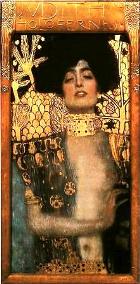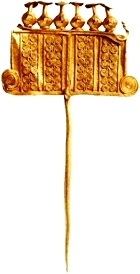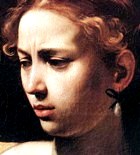Judith – the world she lived in
Who wrote the Book of Judith? We don’t know. But whoever it was, they knew about Middle Eastern history and Jewish religious customs – and about the dangers facing ancient Judah-Israel.
This little country lay between two belligerent, competing empires – not a good spot to be. The people had to be constantly on guard, always ready for trouble.
When was Judith’s story written? Probably during the reign of John Hyrcanus (134-104BC), when the Jewish people, like Judith herself, faced threats from invading foreigners – for ‘Judith’, read ‘Israel’.
Is Judith’s story historically accurate? Sorry, no. It contains details from at least five centuries of real history, all mixed up together. There are historical references to
- Nineveh, the magnificent Assyrian capital destroyed in the 7th century BC
- Nebuchadnezzar, a 6th century BC Babylonian ruler
-
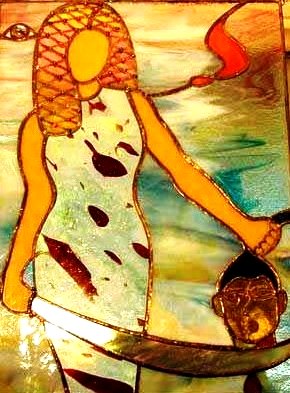
Judith with the head of Holofernes, stained glass installation, Diana Goodpasture
the Second Temple, rebuilt after the return from the Babylonian exile
- two characters with Persian names, Holofernes and Bagoas, who actually figured in the campaigns of Artaxerxes III in the 4th century BC.
In other words, a hodgepodge of historical facts.
But that’s the point. The Book of Judith is not meant to be read as factual history.
- It’s a story with a message of hope in God.
- It has new ideas about God
- that are still relevant today.
These are set within the framework of a racy, engrossing story.
The story teaches that we should
- serve only one God
- turn to God when we are in trouble
- trust God without reserve.
When was the story of Judith set?
Judith’s story was set and written sometime between 586BC and the Roman occupation of Palestine in 63BC. This time period includes major events in Jewish history:
- exile in Babylon,
- the return to Jerusalem, and
- the building of the Second Temple.
It is an important period, since events of this time influenced the way Jews thought about themselves.
Here’s an example: Nebuchadnezzar, the terrifying king of Babylon, destroyed Jerusalem and its Temple in 586BC. Then to avoid trouble he simply removed the aristocracy, members of the upper classes, and all the leading families of Judah. He carted them off to live in exile in Babylon for a period of about fifty years.
How did the Jewish captives survive?
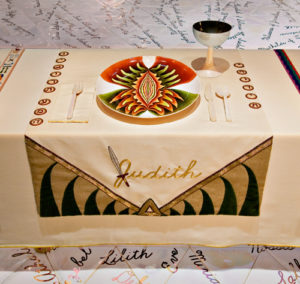
The table setting for Judith from
Judy Chicago’s ‘The Dinner Party’
But they stuck together in Babylon, and survived. They
- lived together, keeping their families intact
- settled in areas of land given to them by the Babylonian authorities
- were not forced to intermarry or become slaves
- were able to be useful and respected members of the Babylonian empire
- adopted Babylonian names, the Babylonian calendar and the Aramaic language (this was the language that Jews such as Jesus spoke in later times)
- assimilated well into Babylonian society, but maintained their Jewish identity.
But they were puzzled. Wasn’t God supposed to protect them? Why then had disaster overwhelmed them?
They had previously assumed that, as Yahweh’s Chosen People they and the Temple would be protected. This assumption had proved wrong. They asked:
- Why had Yahweh made them suffer?
- What had they done to cause the disaster?
- How could such an event be prevented in the future?
Their holy men told them that disaster had struck because they had broken the terms of the covenant with Yahweh. They had not abandoned the fertility gods Asherah and Baal, as they should have. So Yahweh had given them up to their fate.
It followed that if they repented, Yahweh would forgive them.
Hopefully they would be reinstated, and could return to their homeland.
With this in mind, their priests edited and rewrote the Jewish Scriptures, so that the focus was on radical monotheism, the exclusive worship of one god.
In the meantime, the Babylonian empire had collapsed. Now the Persians were in power.
In 538BC Cyrus the Great of Persia allowed certain members of the Jewish captive population to return to Jerusalem, to settle there and rebuild the Temple. This was part of an empire-wide resettlement program, but the Jewish captives saw it as clear evidence that their god Yahweh had accepted their repentance.
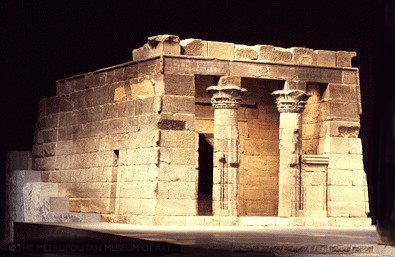
The Temple of Dendur. The Second Temple of Jerusalem may have looked something like this – it was a common design in the ancient world
Over a period of time, the Jews returned to Jerusalem – which in the meantime had fallen into semi-ruin.
Now they set about the task of rebuilding Jerusalem and the Temple, which would be called the Second Temple (the first Temple had been built by Solomon).
They did not have kings any longer to lead and govern them. Judith’s story shows only too clearly what they thought of kings and despots.
Instead, their leaders were the prophets. Two of these prophets, Ezra and Nehemiah, carried out sweeping social reforms that had a direct bearing on the lives of many women.
Attitudes to women at that time
The stories of Judith, faithful Ruth and of beautiful Queen Esther, written in this period, make particular points about women, that:
- they were powerful in their own right, and not to be treated as disposable chattels
- they were as capable of being God’s instruments as men were and sometimes, as in the case of Judith, even more so.
Judith: a Bible movie?
Charles Hill, in his book ‘The Scriptures Jesus Knew’, says that
‘There is no doubt this is colorful material, the stuff “biblical” movies are made of. There is that unbeatable mix of religion, sex and violence—not unique in the Bible, of course, or beyond it.
We find it hard to take seriously the extremes of the piety of Judith (“Jewess”), obviously a religious model, and her prowess with a sword, albeit in the best of causes. She can lecture the villainous general Holofernes on God’s purposes for her people (11.10) and plot his downfall in precise detail.
Is Judith’s story true?
We are further alerted to the composer’s moral and symbolic purposes when we note his clearly deliberate falsification of historical detail: though the story purports to tell of the invasion of Judah under the Babylonian Nebuchadnezzar, the enemy are called Assyrians, the great power dislodged previously by the Babylonians.
And if we turn to the beginning of the book, we find a hopeless mish-mash of Assyrian, Babylonian, Median and Persian names and places that any contemporary reader would know was concocted to discourage them from treating this as straight history.
So why was Judith’s story written?
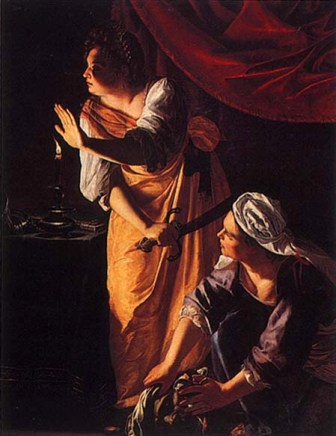
Judith and the Maid-servant with the head of Holofernes, Artemisia Gentileschi
Yet even we clearly perceive the religious and moral message the writer is conveying under this pseudo-historical guise, and this leads us to surmise its purpose and perhaps circumstances of composition.
The model Jewess, with her devotion to the God of Israel, Mosaic Law and Temple cult in the face of foreign aggression and pagan pressure, is obviously meant to be an example to a people under similar pressure from some foreign culture later than the Persians—perhaps the Greeks.
Who wrote the Book of Judith?
Nothing is known about the author beyond these doctrinal positions within the text, suggesting pharisaic authorship in Hellenistic times, in Hebrew, perhaps early first century.
We read the chapters again, accepting the strong message of fidelity the author is giving to a community under pressure to defect, recognizing the curiously independent part played by this ideal woman who can uphold Law and at the same time
- practice deception,
- behead despots,
- put the males of the community to shame.
Not too many women in Israel are accorded the accolade. ‘You are the glory of Jerusalem, the great boast of Israel, the great pride of our nation’ (15.9)!
Could that be a further reason for the book’s later exclusion from the Jewish canon? Its religious value for its own community (and ours?) is not in doubt.’ (p36-37)
Hill, Charles, The Scriptures Jesus Knew: a Guide to the Old Testament, E J Dwyer, 1994
For additional information on the lives of women in the Bible, see the links to
Family, work and religion: the tribe, the family, slaves, women’s tasks, beliefs
Milestones in a woman’s life: Puberty, menstruation, marriage, childbirth, death, burials
Read about more fascinating women of the Bible
Search Box
![]()
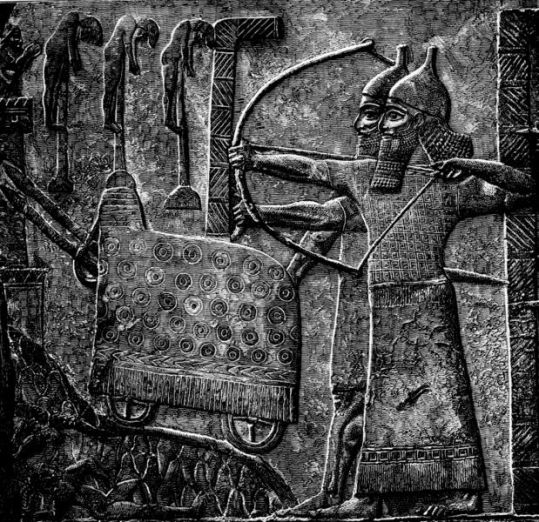
Assyrian archers, a city under siege with siege machines to batter down the walls; prisoners impaled on the city walls; carved wall relief
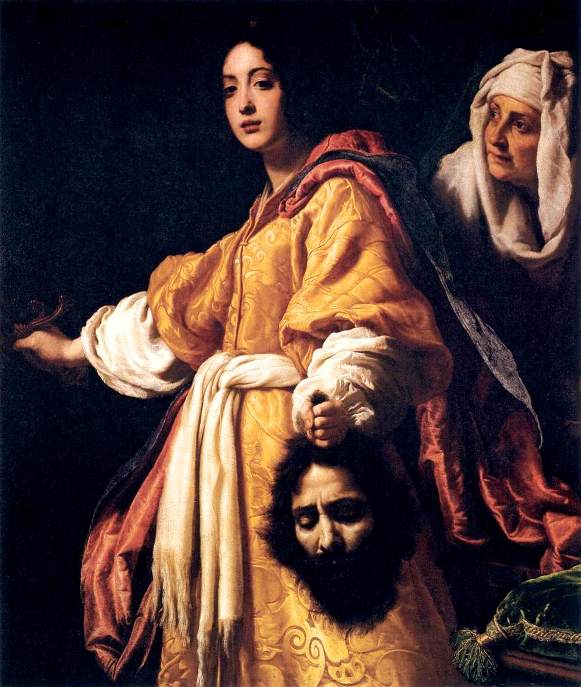
Judith used weapons of a different kind. Judith with the head of Holofernes, Cristofano Allori
Judith story
Judith links
Bible Bad Men: Nebuchadnezzar
What a villain!
Movies

Make a list of films about women who, like Judith, had to kill an enemy to save their people
© Copyright 2006
Elizabeth Fletcher






